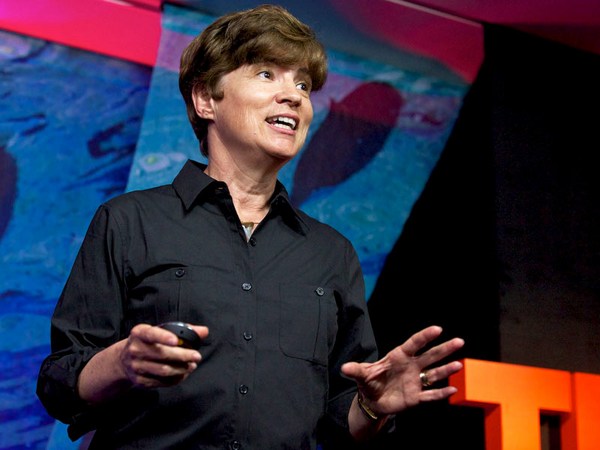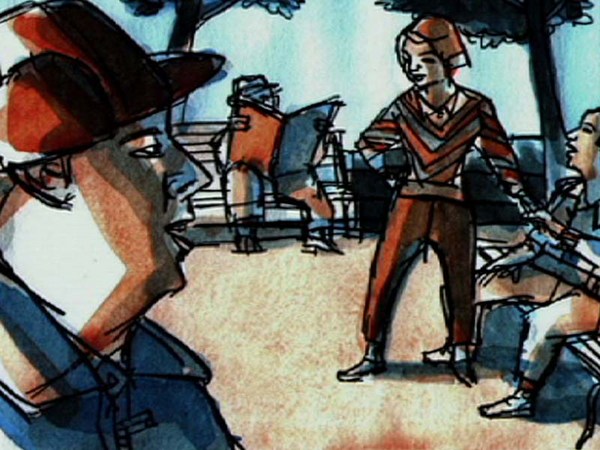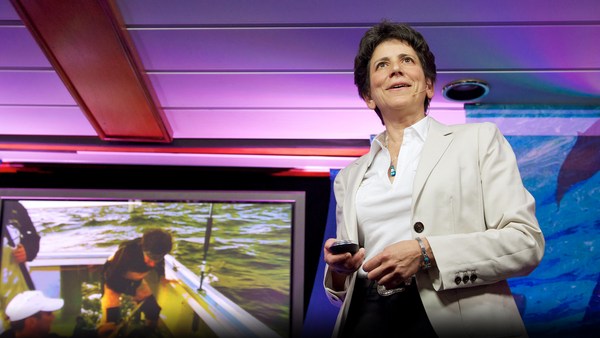Cartoons are basically short stories. I tried to find one that didn't have a whole lot of words. Not all of them have happy endings. So how did I get started cartooning? I doodled a lot as a kid, and if you spend enough time doodling, sooner or later, something happens: all your career options run out. So you have to make a living cartooning.
Actually, I fell in love with the ocean when I was a little boy, when I was about eight or nine. And I was particularly fascinated with sharks. This is some of my early work. Eventually, my mom took the red crayon away, so it was [unclear]. But I'd like to relay to you a childhood experience of mine that really made me see the ocean differently, and it's become the foundation of my work because, I feel like, if in a day, I can see the ocean differently, then I can evoke that same kind of change in others, especially kids. Before that day, this is how I saw the ocean. It's just a big blue surface. And this is how we've seen the ocean since the beginning of time. It's a mystery. There's been a lot of folklore developed around the ocean, mostly negative. And that prompted people to make maps like this, with all kinds of wonderful detail on the land, but when you get to the waters edge, the ocean looks like one giant puddle of blue paint. And this is the way I saw the ocean at school -- as if to say, "All geography and science lessons stop at water's edge. This part's not going to be on the test."
But that day I flew low over the islands -- it was a family trip to the Caribbean, and I flew in a small plane low over the islands. This is what I saw. I saw hills and valleys. I saw forests and meadows. I saw grottoes and secret gardens and places I'd love to hide as a kid, if I could only breathe underwater. And best of all, I saw the animals. I saw a manta ray that looked as big as the plane I was flying in. And I flew over a lagoon with a shark in it, and that was the day that my comic strip about a shark was born.
So from that day on, I was an ordinary kid walking around on dry land, but my head was down there, underwater. Up until that day, these were the animals that were most common in my life. These were the ones I'd like to draw -- all variations of four legs and fur. But when you got to the ocean, my imagination was no competition for nature. Every time I'd come up with a crazy cartoon character on the drawing board, I'd find a critter in the ocean that was even crazier. And the differences in scale between this tiny sea dragon and this enormous humpback whale was like something out of a science-fiction movie.
Whenever I talk to kids, I always like to tell them, the biggest animal that ever lived is still alive. It's not a dinosaur; it's a whale, animals as big as office buildings still swimming around out there in our ocean. Speaking of dinosaurs, sharks are basically the same fish they were 300 million years ago. So if you ever fantasize about going back in time and seeing what a dinosaur looked like, that's what a dinosaur looks like. So you have living dinosaurs and space aliens, animals that evolved in zero gravity in harsh conditions. It's just incredible; no Hollywood designer could come up with something more interesting than that. Or this fangtooth. The particles in the water make it look like it's floating in outer space. Could you image if we looked through the Hubble Telescope and we saw that? It would start a whole new space race. But instead, we stick a camera in the deep ocean, and we see a fish, and it doesn't capture our imagination as a society. We say to ourselves, "Maybe we can make fish sticks with it or something."
So, what I'd like to do now is try a little drawing. So, I'm going to try to draw this fangtooth here. I love to draw the deep sea fish, because they are so ugly, but beautiful in their own way. Maybe we can give him a little bioluminescence here -- give him a headlight, maybe a brake light, turn signals. But it's easy to see why these animals make such great cartoon characters, their shapes and sizes. So some of them actually seem to have powers like superheroes in a comic book. For instance, take these sea turtles. They kind of have a sixth sense like Superman's x-ray vision. They can sense the magnetic fields of the earth. And they can use that sense to navigate hundreds of miles of open ocean. I kind of give my turtle hands just to make them an easier cartoon character to work with. Or take this sea cucumber. It's not an animal we draw cartoons of or draw at all. He's like an underwater Spiderman. He shoots out these sticky webs to entangle his enemy. Of course, sea cucumbers shoot them out their rears, which, in my opinion, makes them much more interesting a superhero. (Laughter) He can't spin a web anytime; he's got to pull his pants down first.
(Laughter)
Or the blowfish. The blowfish is like the Incredible Hulk. It can change its body into a big, intimidating fish in a matter of seconds. I'm going to draw this blowfish uninflated. And then I'm going to attempt onscreen animation here. Let's see. Try and inflate it. (Laughter) "You talkin' to me?" See, he can inflate himself when he wants to be intimidating. Or take this swordfish. Could you imagine being born with a tool for a nose? Do you think he wakes up in the morning, looks in the mirror and says, "Somebody's getting stabbed today." Or this lionfish for instance. Imagine trying to make friends covered with razor-sharp poisonous barbs. It's not something you want to put on your Facebook page, right?
My characters are -- my lead character's a shark named Sherman. He's a great white shark. And I kind of broke the mold with Sherman. I didn't want to go with this ruthless predator image. He's kind of just out there making a living. He's sort of a Homer Simpson with fins. And then his sidekick is a sea turtle, as I mentioned before, named Filmore. He uses his wonderful skills at navigation to wander the oceans, looking for a mate. And he does manage to find them, but great navigation skills, lousy pick-up lines. He never seems to settle on any particular girl. I have a hermit crab named Hawthorne, who doesn't get a lot of respect as a hermit crab, so he kind of wishes he were a great white shark. And then I'll introduce you to one more character, this guy, Ernest, who is basically a juvenile delinquent in a fish body.
So with characters, you can make stories. Sometimes making a story is as easy as putting two characters in a room and seeing what happens. So, imagine a great white shark and a giant squid in the same bathroom. (Laughter) Or, sometimes I take them to places that people have never heard of because they're underwater. For instance, I took them skiing in the Mid-Atlantic Range, which is this range of mountains in the middle of the Atlantic. I've taken them to the Sea of Japan, where they met giant jellyfish. I've taken them camping in the kelp forests of California.
This next one here, I did a story on the census of marine life. And that was a lot of fun because, as most of you know, it's a real project we've heard about. But it was a chance for me to introduce readers to a lot of crazy undersea characters. So we start off the story with Ernest, who volunteers as a census taker. He goes down and he meets this famous anglerfish. Then he meets the yeti crab, the famous vampire squid -- elusive, hard to find -- and the Dumbo octopus, which looks so much like a cartoon in real life that really didn't have to change a thing when I drew it.
I did another story on marine debris. I was speaking to a lot of my friends in the conservation business, and they -- I asked them, "So what's one issue you would like everyone to know more about?" And they said -- this one friend of mine said, "I've got one word for you: plastic." And I told him, "Well, I need something a little sexier than that. Plastic just is not going to do it." We sort of worked things out. He wanted me to use words like polyvinyl chloride, which doesn't really work in voice balloons very well. I couldn't fit them in. So what I did was I made an adventure strip.
Basically, this bottle travels a long way. What I'm trying to tell readers is that plastic doesn't really go away; it just continues to wash downstream. And a lot of it ends up washing into the ocean, which is a great story if you attach a couple characters to it, especially if they can't stand each other, like these two. So, I sent them to Boise, Idaho, where they dropped a plastic bottle into the Boise sewer system. And it ended up in the Boise River and then on to the Columbia River and then to the mouth of the Columbia and to the Pacific Ocean and then on to this place called the Great Pacific Garbage Patch -- which is this giant Pacific gyre in the North Pacific, where a lot of this plastic ends up floating around -- and then back onto the lagoon. So that was basically a buddy story with a plastic bottle following along. So a lot of people remember the plastic bottle anyway, but we really talked about marine debris and plastic in the course of that one.
The third storyline I did about a year and a half ago was probably my most difficult. It was on shark finning, and I felt really strongly about this issue. And I felt like, since my main character was a shark, the comic strip was a perfect vehicle for telling the public about this. Now, finning is the act of taking a shark, cutting the valuable fins off and throwing the live animal back in the water. It's cruel, it's wasteful. There's nothing funny or entertaining about it, but I really wanted to take this issue on. I had to kill my main character, who is a shark.
We start with Sherman in a Chinese restaurant, who gets a fortune that he's about to get caught by a trawler, which he does. And then he dies. He gets finned, and then he gets thrown overboard. Ostensibly, he's dead now. And so I killed a character that's been in the newspaper for 15 years. So I got a lot of reader feedback on that one. Meanwhile, the other characters are talking about shark fin soup. I do three or four strips after that where we explore the finning issue and the shark fin soup issue. Sherman's up in shark heaven. This is what I love about comic strips, you know. You really don't have to worry about the audience suspending its sense of disbelief because, if you start with a talking shark, readers pretty much check their disbelief at the door. You can kind of do anything. It becomes a near-death experience for Sherman. Meanwhile, Ernest finds his fins on the internet. There was a real website based in China that actually sold shark fins, so I kind of exposed that. And he clicks the "buy now" button. And voila, next-day air, they show up, and they surgically reattach them. I ended that series with a kind of a mail-in petition that encouraged our National Marine Fishery Service, to force other countries to have a stronger stance with shark management.
(Applause)
Thanks. I'd like to end with a little metaphor here. I've been trying to think of a metaphor to represent Mission Blue, and this is what I came up with. Imagine you're in an enormous room, and it's as dark as a cave. And you can have anything in that room, anything you want, but you can't see anything. You've been given one tool, a hammer. So you wander around in the darkness, and you bump into something, and it feels like it's made of stone. It's big, it's heavy. You can't carry it away, so you bang it with your hammer, and you break off a piece. And you take the piece out into the daylight. And you see you have a beautiful piece of white alabaster. So you say to yourself, "Well, that's worth something." So you go back into the room, and you break this thing to pieces, and you haul it away. And you find other things, and you break that up, and you haul those away. And you're getting all kinds of cool stuff. And you hear other people doing the same thing. So you get this sense of urgency, like you need to find as much stuff as possible as soon as possible. And then some yells, "Stop!" And they turn up the lights. And you realize where you are; you're in the Louvre. And you've taken all this complexity and beauty, and you've turned it into a cheap commodity.
And that's what we're doing with the ocean. And part of what Mission Blue is about is yelling, "Stop!" so that each of us -- explorer, scientist, cartoonist, singer, chef -- can turn up the lights in their own way. And that's what I hope my comic strip does in a small way. That's why I like what I do.
Thanks for listening.
(Applause)





